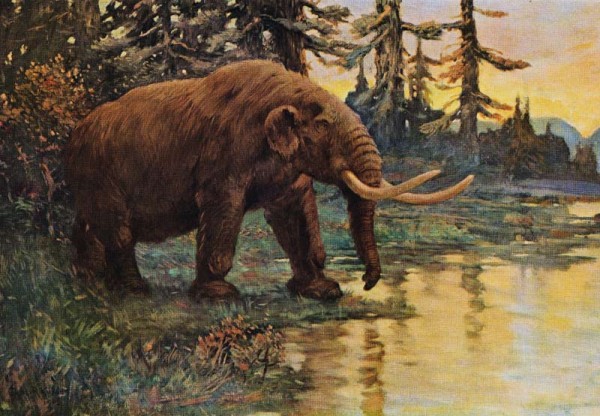In the 1920’s and 1930’s, a great number of distinctive stone tools were found near Clovis, New Mexico. Named “Clovis points,” their size and symmetrical shape, along with the indents found on either side of each specimen, indicated that these were spear tips. These Clovis points were often found in close association with mastodon remains, and unequivocal evidence for the hunting of mastodons with these tools was later discovered at a kill site in Kimmswick, Missouri. The only direct evidence of the “Clovis people” available are these sites, and thus we know very little about them (Tankersley, Waters and Stafford 2009, 566). However, by considering what we do know about them and relating it to general characteristics of modern hunter-gather societies, we can infer more about the lives of these ancient people than one might think.

Artist rendition of American mastodon
First, we must establish that the Clovis people were modern humans so that the generalizations made can be applied to them. Besides the fact that it is generally accepted by the scientific community that Homo Sapiens were the only human species to reach the Americas, the Clovis people themselves demonstrated that they are Homo Sapiens through their construction and use of complex tools. In Big Bone Lick, Kentucky, Clovis points were found alongside blade tools, one which was shown to be struck from a prepared polyhedral core made of Fort Payne chert, which was likely found locally (Tankersley, Waters and Stafford 2009, 566). Such tool specialization and complexity in design has only ever been connected with groups of Homo Sapiens. The Clovis people had an end goal in mind before the creation of these tools, and as such they are clear indicators of a level of thinking only matched by Homo Sapiens.

Clovis points from various North American sites
Enactivist theory in cognitive science posits that cognition, and by extension reflections of higher cognition such as social organization and culture, arise from interactions between an organism and its environment. In hunter-gatherer societies, because the subsistence of the society depends wholly on the natural world and one’s ability to navigate it, traditions surrounding the belief that nature and animals are sacred often develop. Thus, using enactivist theory, we can speculate that the Clovis people had a reverence for the mastodon, likely had a pantheon of gods or spirits which coincided with their perceived distinct elements of nature, and lived in closely-knit, mostly egalitarian units which would have facilitated their main method of subsistence, hunting (Evy Van 2020, 306).
Additional Links
3-D computer analysis of Clovis points:
To learn more about finding evidence for mastodon butchery:
Image Links
Mastodon:
https://www.gear-gear.com/blog/wp-content/uploads/2015/03/Mastodon.jpg
Clovis Points:
Works Cited
Cauteren, Evy Van. 2020. “Hunting Ideology and Ritual Treatment of Animal Remains in Hunter- Gatherer Societies: An Enactive Anthropological Approach.” Journal of anthropological research 76, no. 3 (2020): 296–325. Chicago: The University of Chicago Press.
Tankersley, Kenneth B, Michael R Waters, and Thomas W Stafford. Jul., 2009. “Clovis and the American Mastodon at Big Bone Lick, Kentucky.” American antiquity 74, no. 3 (2009): 558–567. Cambridge: Cambridge University Press.

How does our understanding of lithic technology help us interpret that these Clovis points were used specifically as spear tips, without any perishable materials like sinew or wood preserved in the record?